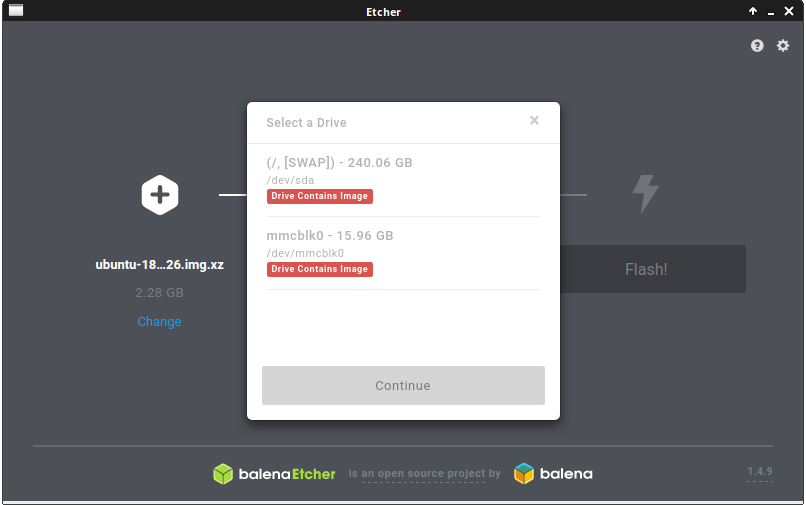

- #Balena etcher clone drive how to
- #Balena etcher clone drive install
- #Balena etcher clone drive Pc
- #Balena etcher clone drive download
I don't want to (can't) use dd because the SD card #3 is only 16 GB, whereas the #1 SD card is 32 GB, and my armbian installation takes only 4,1 GB.
#Balena etcher clone drive download
Download the PiShrink script, and make it executable.Update: I tried to clone the SD card doing the following, inspiration from this thread:ġ) download armbian image, burn to another SD card (#2)Ģ) run armbian from this SD card #2 (works)ģ) insert former boot SD card (#1) and backup SD card (#3) in SD card readerĤ) dd if=/dev/#1 of=/dev/#3 bs=1M count=4 (to copy partition scheme and bootloader)ĥ) mount #1 /mnt/origin, mount #3 /mnt/cloneĦ) rsync -avSz /mnt/origin /mnt/clone (seems to work)ħ) check /etc/fstab on #3, adjust UUID of /Ĩ) try to boot from #3 -> doesn't work :-(
#Balena etcher clone drive install
If you do not have Linux installed, you can install the latest version of Ubuntu or Linux Mint in a virtual machine, and run this script there. It is a handy tool to have if you want to save a boot image in a flash. It is a hassle-free solution that allows you to burn your chosen OS to an SD card and other removable hard-drives without any complications. Unfortunately, this tool is only available on Linux. balenaEtcher is a recommended app if you are looking for an efficient image burning tool. This also makes copying the image back onto the SD card much faster. To work around this limitation, we will use PiShrink, a script that automatically shrinks a Pi image that will then automatically resize to the max size of the SD card on boot. This is fine if you only have one or two such images, but any more than that (especially if you use an SSD) will cause you to run out of space. For example, cloning an SD card with a capacity of 32GB will create an image file of 32 GB, even if only 5 GB is actually in use on the card.
#Balena etcher clone drive how to
How to Shrink the Cloned Raspberry Pi Image (Linux-only)Īs mentioned at the starting of the article, these methods create an image file that is equal to the total capacity of the SD card. You can then remove the card from your Mac, and insert it back in the Raspberry Pi. Once the write is complete, you will see a confirmation from dd.
#Balena etcher clone drive Pc
Insert the micro SD card that you want to clone in your PC using a USB or built-in card reader. Windows Instructions Backup Raspberry Pi SD Cardġ. Using a drive as source, and cloning it to multiple drives. If you use the latest version of Etcher (v1.1.2) you should find that Etcher is able to write your disk-image without any problem :) The reason that Windows shows the disk as having a capacity of 3,955,228,672 bytes is because this is the capacity of the filesystem, not of the raw disk.

There is a method to shrink the image size, but it works only on Linux, and we will be explaining it later in the tutorial. For example, if you have a 16 GB SD card, the resulting image file will also be 16 GB, no matter how much space your installation is actually using. Note: This method will create an image file exactly the size of the SD card’s total capacity. We will explain how to do it on Windows, Linux, and finally macOS. So today, we will learn how to clone or backup the Raspberry Pi micro SD card to an image file, and restore the image after we are done experimenting. Shut down the computer while leaving the USB stick. In both the above scenarios, it is helpful to have an exact, bit-by-bit identical backup of your working Raspberry Pi installation. balenaEtcher from Windows balenaEtcher from macOS GNOME Disks from Linux the Linux command line. Problem is, you only have one micro SD card, and already have a working installation on it that you do not want to lose. Another common scenario is let’s say, you just got to know about a cool new Raspberry Pi-based project or Linux distro, and you are dying to try it out. Etcher on Windows v1.5.107, 1.5.108, 1.5.109 and, 1.5.110 has a bug in the clone drive feature that erases the partition table of the source disk.


 0 kommentar(er)
0 kommentar(er)
